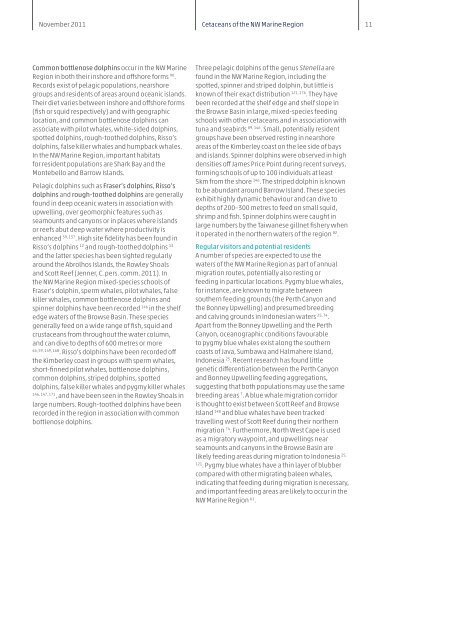Australia's last great whale haven.pdf - Ningaloo Atlas
Australia's last great whale haven.pdf - Ningaloo Atlas
Australia's last great whale haven.pdf - Ningaloo Atlas
- TAGS
- whale
- ningaloo
- atlas
- www.ifaw.org
You also want an ePaper? Increase the reach of your titles
YUMPU automatically turns print PDFs into web optimized ePapers that Google loves.
November 2011 Cetaceans of the NW Marine Region<br />
11<br />
Common bottlenose dolphins occur in the NW Marine<br />
Region in both their inshore and offshore forms 90 .<br />
Records exist of pelagic populations, nearshore<br />
groups and residents of areas around oceanic islands.<br />
Their diet varies between inshore and offshore forms<br />
(fish or squid respectively) and with geographic<br />
location, and common bottlenose dolphins can<br />
associate with pilot <strong>whale</strong>s, white-sided dolphins,<br />
spotted dolphins, rough-toothed dolphins, Risso’s<br />
dolphins, false killer <strong>whale</strong>s and humpback <strong>whale</strong>s.<br />
In the NW Marine Region, important habitats<br />
for resident populations are Shark Bay and the<br />
Montebello and Barrow Islands.<br />
Pelagic dolphins such as Fraser’s dolphins, Risso’s<br />
dolphins and rough-toothed dolphins are generally<br />
found in deep oceanic waters in association with<br />
upwelling, over geomorphic features such as<br />
seamounts and canyons or in places where islands<br />
or reefs abut deep water where productivity is<br />
enhanced 59, 137 . High site fidelity has been found in<br />
Risso’s dolphins 12 and rough-toothed dolphins 13<br />
and the latter species has been sighted regularly<br />
around the Abrolhos Islands, the Rowley Shoals<br />
and Scott Reef (Jenner, C. pers. comm. 2011). In<br />
the NW Marine Region mixed-species schools of<br />
Fraser’s dolphin, sperm <strong>whale</strong>s, pilot <strong>whale</strong>s, false<br />
killer <strong>whale</strong>s, common bottlenose dolphins and<br />
spinner dolphins have been recorded 146 in the shelf<br />
edge waters of the Browse Basin. These species<br />
generally feed on a wide range of fish, squid and<br />
crustaceans from throughout the water column,<br />
and can dive to depths of 600 metres or more<br />
46, 59, 149, 168 . Risso’s dolphins have been recorded off<br />
the Kimberley coast in groups with sperm <strong>whale</strong>s,<br />
short-finned pilot <strong>whale</strong>s, bottlenose dolphins,<br />
common dolphins, striped dolphins, spotted<br />
dolphins, false killer <strong>whale</strong>s and pygmy killer <strong>whale</strong>s<br />
146, 147, 171 , and have been seen in the Rowley Shoals in<br />
large numbers. Rough-toothed dolphins have been<br />
recorded in the region in association with common<br />
bottlenose dolphins.<br />
Three pelagic dolphins of the genus Stenella are<br />
found in the NW Marine Region, including the<br />
spotted, spinner and striped dolphin, but little is<br />
known of their exact distribution 121, 176 . They have<br />
been recorded at the shelf edge and shelf slope in<br />
the Browse Basin in large, mixed-species feeding<br />
schools with other cetaceans and in association with<br />
tuna and seabirds 89, 146 . Small, potentially resident<br />
groups have been observed resting in nearshore<br />
areas of the Kimberley coast on the lee side of bays<br />
and islands. Spinner dolphins were observed in high<br />
densities off James Price Point during recent surveys,<br />
forming schools of up to 100 individuals at least<br />
5km from the shore 146 . The striped dolphin is known<br />
to be abundant around Barrow Island. These species<br />
exhibit highly dynamic behaviour and can dive to<br />
depths of 200–300 metres to feed on small squid,<br />
shrimp and fish. Spinner dolphins were caught in<br />
large numbers by the Taiwanese gillnet fishery when<br />
it operated in the northern waters of the region 82 .<br />
Regular visitors and potential residents<br />
A number of species are expected to use the<br />
waters of the NW Marine Region as part of annual<br />
migration routes, potentially also resting or<br />
feeding in particular locations. Pygmy blue <strong>whale</strong>s,<br />
for instance, are known to migrate between<br />
southern feeding grounds (the Perth Canyon and<br />
the Bonney Upwelling) and presumed breeding<br />
and calving grounds in Indonesian waters 25, 74 .<br />
Apart from the Bonney Upwelling and the Perth<br />
Canyon, oceanographic conditions favourable<br />
to pygmy blue <strong>whale</strong>s exist along the southern<br />
coasts of Java, Sumbawa and Halmahere Island,<br />
Indonesia 25 . Recent research has found little<br />
genetic differentiation between the Perth Canyon<br />
and Bonney Upwelling feeding aggregations,<br />
suggesting that both populations may use the same<br />
breeding areas 7 . A blue <strong>whale</strong> migration corridor<br />
is thought to exist between Scott Reef and Browse<br />
Island 148 and blue <strong>whale</strong>s have been tracked<br />
travelling west of Scott Reef during their northern<br />
migration 74 . Furthermore, North West Cape is used<br />
as a migratory waypoint, and upwellings near<br />
seamounts and canyons in the Browse Basin are<br />
likely feeding areas during migration to Indonesia 25,<br />
121 . Pygmy blue <strong>whale</strong>s have a thin layer of blubber<br />
compared with other migrating baleen <strong>whale</strong>s,<br />
indicating that feeding during migration is necessary,<br />
and important feeding areas are likely to occur in the<br />
NW Marine Region 61 .

















